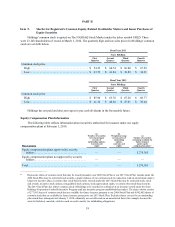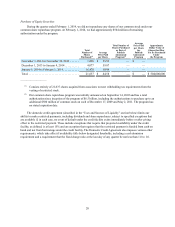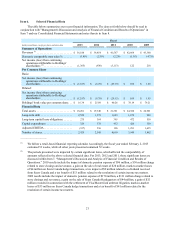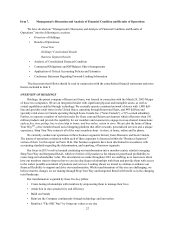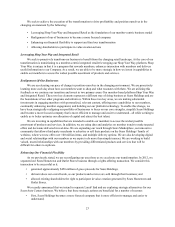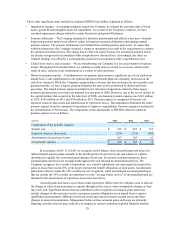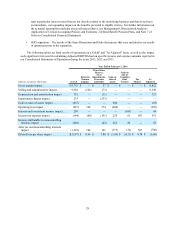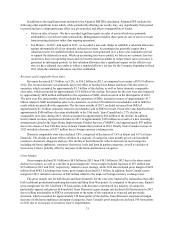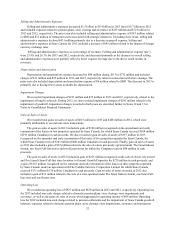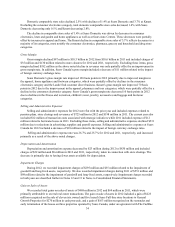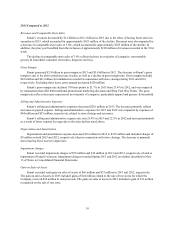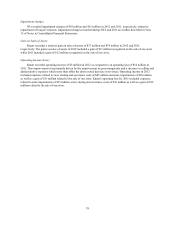Sears 2013 Annual Report Download - page 28
Download and view the complete annual report
Please find page 28 of the 2013 Sears annual report below. You can navigate through the pages in the report by either clicking on the pages listed below, or by using the keyword search tool below to find specific information within the annual report.
28
These other significant items included in Adjusted EBITDA are further explained as follows:
• Impairment charges – Accounting standards require the Company to evaluate the carrying value of fixed
assets, goodwill and intangible assets for impairment. As a result of the Company’s analysis, we have
recorded impairment charges related to certain fixed asset and goodwill balances.
• Pension settlements – The Company amended its domestic pension plan and offered a one-time voluntary
lump sum payment option in an effort to reduce its long-term pension obligations and ongoing annual
pension expense. The pension settlements were funded from existing pension plan assets. In connection
with this transaction, the Company incurred a charge to operations as a result of the requirement to expense
the unrealized actuarial losses. The charge had no effect on equity because the unrealized actuarial losses
are already recognized in accumulated other comprehensive income/(loss). Accordingly, the effect on
retained earnings was offset by a corresponding reduction in accumulated other comprehensive loss.
• Closed store reserve and severance – We are transforming our Company to a less asset-intensive business
model. Throughout this transformation, we continue to make choices related to our stores, which could
result in sales, closures, lease terminations or a variety of other decisions.
• Domestic pension expense – Contributions to our pension plans remain a significant use of our cash on an
annual basis. Cash contributions to our pension and postretirement plans are separately disclosed on the
cash flow statement. While the Company's pension plan is frozen, and thus associates do not currently earn
pension benefits, we have a legacy pension obligation for past service performed by Kmart and Sears
associates. The annual pension expense included in our statement of operations related to these legacy
domestic pension plans was relatively minimal in years prior to 2009. However, due to the severe decline in
the capital markets that occurred in the latter part of 2008, our domestic pension expense was $162 million
in 2013, $165 million in 2012 and $74 million in 2011. Pension expense is comprised of interest cost,
expected return on plan assets and amortization of experience losses. This adjustment eliminates the entire
pension expense from the statement of operations to improve comparability. Pension expense is included in
the determination of Net Income. The components of the adjustments to EBITDA related to domestic
pension expense were as follows:
millions 2013 2012 2011
Components of net periodic expense:
Interest cost. . . . . . . . . . . . . . . . . . . . . . . . . . . . . . . . . . . . . . . . . . . $ 219 $ 291 $ 313
Expected return on plan assets . . . . . . . . . . . . . . . . . . . . . . . . . . . . (224)(291)(302)
Amortization of experience losses . . . . . . . . . . . . . . . . . . . . . . . . . 167 165 63
Net periodic expense. . . . . . . . . . . . . . . . . . . . . . . . . . . . . . . . . . . . $ 162 $ 165 $ 74
In accordance with U.S. GAAP, we recognize on the balance sheet actuarial gains and losses for
defined benefit pension plans annually in the fourth quarter of each fiscal year and whenever a plan is
determined to qualify for a remeasurement during a fiscal year. For income statement purposes, these
actuarial gains and losses are recognized throughout the year through an amortization process. The
Company recognizes in its results of operations, as a corridor adjustment, any unrecognized actuarial net
gains or losses that exceed 10% of the larger of projected benefit obligations or plan assets. Accumulated
gains/losses that are inside the 10% corridor are not recognized, while accumulated actuarial gains/losses
that are outside the 10% corridor are amortized over the "average future service" of the population and are
included in the amortization of experience losses line item above.
Actuarial gains and losses occur when actual experience differs from the estimates used to allocate
the change in value of pension plans to expense throughout the year or when assumptions change, as they
may each year. Significant factors that can contribute to the recognition of actuarial gains and losses
include changes in discount rates used to remeasure pension obligations on an annual basis or upon a
qualifying remeasurement, differences between actual and expected returns on plan assets and other
changes in actuarial assumptions. Management believes these actuarial gains and losses are primarily
financing activities that are more reflective of changes in current conditions in global financial markets


